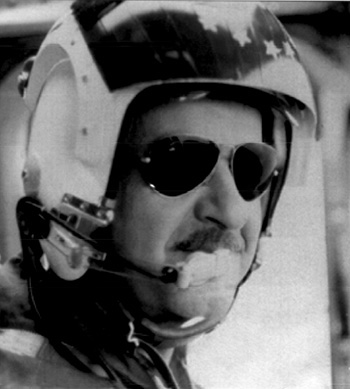
|
William H. Huffcut |
 |
|||
| Rank, Service | ||||
Colonel O-6, U.S. Marine Corps |
||||
| Veteran of: | ||||
|
||||
| Tribute: | ||||
Bill Huffcut was born on May 11, 1935, in New York. He was commissioned a 2d Lt in the U.S. Marine Corps on October 20, 1958, and completed The Basic School at MCS Quantico, Virginia, in August 1959. His first assignment was as an Infantry Officer with 2nd Battalion, 6th Marine Regiment of the 2nd Marine Division at Camp Lejeune, North Carolina, from August 1959 to January 1961, followed by Flight Training at NAS Pensacola, Florida, and NAS Kingsville, Texas, from February 1961 until he was designated a Naval Aviator on July 6, 1962. His next assignment was as an F8U Crusader pilot VMF-251 at MCAS Beaufort, South Carolina, from August 1962 to February 1963, and then as an H-34 Seahorse helicopter pilot with HMM-262 at MCAS New River, North Carolina, from March 1964 to January 1965. During his time with VMF-251, he flew 6 missions in support of the Cuban Missile Crisis in 1962. Capt Huffcut then served as an H-34 pilot with HMM-263 at MCAS New River from February to June 1965, during which time he participated in the Invasion of the Dominican Republic in 1965. He deployed with HMM-263 to Marble Mountain, South Vietnam, from July to October 1965, served as an H-34 pilot with HMM-363 at Qui Nhon, South Vietnam, from November 1965 to February 1966, and finally served as a UH-1E Iroquois pilot with VMO-6 at Chu Lai, South Vietnam, from March to August 1966. His next assignment was with Headquarters U.S. Marine Corps in the Pentagon from September 1966 to January 1969, followed by OV-10 Bronco transition training with VMO-1 at MCAS New River from February to May 1969. Maj Huffcut then served as an OV-10 and UH-1E pilot and as an Intelligence Officer with VMO-6 at Quang Tri, South Vietnam, from June to December 1969, having flown 1,000 combat missions between his two tours in Southeast Asia. He next served as an Adjutant with H&MS-36 in Marine Aircraft Group 36 at MCAS Futenma, Okinawa, from December 1969 to June 1970, followed by Air Command and Staff College at Maxwell AFB, Alabama, from June 1970 to July 1971. His next assignment was as an O-2B Milirole pilot, as a Plans and Policy Officer, and Director of J-5 with U.S. Southern Command in the Panama Canal Zone from August 1971 to July 1974, and then as an OV-10 and UH-1N pilot and Commanding Officer of H&MS-29 at MCAS New River from August 1974 to April 1975. LtCol Huffcut served as an OV-10 pilot and Commanding Officer of VMO-1 at MCAS New River from May 1975 to October 1976, and then served as an OV-10 and AH-1J Sea Cobra pilot and Commanding Officer of Marine Aircraft Group 41 at NAS Atlanta, Georgia, from August 1979 to May 1981. Col Huffcut served as Commanding Officer of Marine Aircraft Group 29 at MCAS New River from June 1981 to February 1983, and then served as Division Air Officer with the 2nd Marine Division at MCB Camp Lejeune from March to June 1983. His next assignment was as Chief of Staff of the 6th Amphibious Marine Brigade at Camp Lejeune from July 1983 to June 1985, followed by service as the U.S. Marine Corps Advisor to the Commander of Air University at Maxwell AFB from July 1985 until his retirement from the Marine Corps on July 1, 1989. |
||||
|
||||

